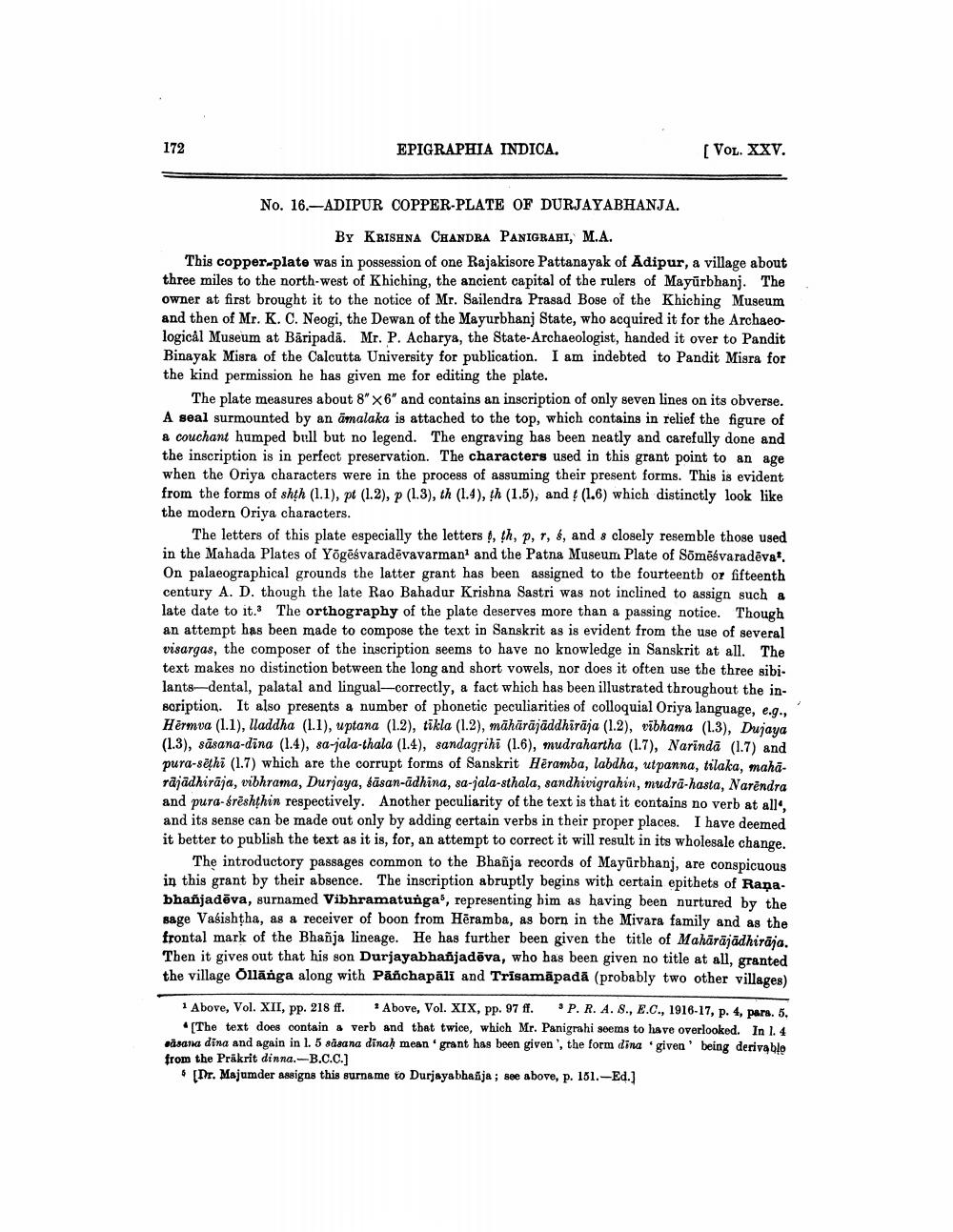________________
172
EPIGRAPHIA INDICA.
(VOL. XXV.
No. 16.-ADIPUR COPPER-PLATE OF DURJAYABHANJA.
BY KRISHNA CHANDRA PANIGRAHI, M.A. This copper-plate was in possession of one Rajakisore Pattanayak of Adipur, a village about three miles to the north-west of Khiching, the ancient capital of the rulers of Mayūrbhanj. The owner at first brought it to the notice of Mr. Sailendra Prasad Bose of the Khiching Museum and then of Mr. K. C. Neogi, the Dewan of the Mayurbhanj State, who acquired it for the Archaeological Museum at Bāripada. Mr. P. Acharya, the State-Archaeologist, handed it over to Pandit Binayak Misra of the Calcutta University for publication. I am indebted to Pandit Migra for the kind permission he has given me for editing the plate.
The plate measures about 8" X 6" and contains an inscription of only seven lines on its obverse. A seal surmounted by an amalaka is attached to the top, which contains in relief the figure of a couchant humped bull but no legend. The engraving has been neatly and carefully done and the inscription is in perfect preservation. The characters used in this grant point to an age when the Oriya characters were in the process of assuming their present forms. This is evident from the forms of shth (1.1), pt (1.2), p (1.3), th (1.4), th (1.5), and ! (1.6) which distinctly look like the modern Oriya characters.
The letters of this plate especially the letters t, th, p, r, 6, and closely resemble those used in the Mahada Plates of Yögēsvaradēvavarmand and the Patna Museum Plate of Sõmēsvaradēva. On palaeographical grounds the latter grant has been assigned to the fourteentb or fifteenth century A. D. though the late Rao Bahadur Krishna Sastri was not inclined to assign such a late date to it. The orthography of the plate deserves more than a passing notice. Though an attempt has been made to compose the text in Sanskrit as is evident from the use of several visargas, the composer of the inscription seems to have no knowledge in Sanskrit at all. The text makes no distinction between the long and short vowels, nor does it often use the three sibi. lants-dental, palatal and lingual-correctly, a fact which has been illustrated throughout the inscription. It also presents a number of phonetic peculiarities of colloquial Oriya language, e.g., Hermva (1.1), lladdha (1.1), uptana (1.2), tikla (1.2), māhārājāddhiraja (1.2), vibhama (1.3). Dulava (1.3), sāsana-dina (1.4), sa-jala-thala (1.4), sandagrihi (1.6), mudrahartha (1.7), Narindā (1.7) and pura-sēļhi (1.7) which are the corrupt forms of Sanskrit Hēramba, labdha, utpanna, tilaka, mahā. rajadhirāja, vibhrama, Durjaya, sāsan-adhina, sa-jala-sthala, sandhivigrahin, mudrā-hasta, Narendra and pura-śrēshthin respectively. Another peculiarity of the text is that it contains no verb at all, and its sense can be made out only by adding certain verbs in their proper places. I have deemed it better to publish the text as it is, for, an attempt to correct it will result in its wholesale change.
The introductory passages common to the Bhañja records of Mayurbhanj, are conspicuous in this grant by their absence. The inscription abruptly begins with certain epithets of Raņabhañjadēva, surnamed Vibhramatunga, representing him as having been nurtured by the sage Vasishtha, as a receiver of boon from Hēramba, as born in the Mivara family and as the frontal mark of the Bhañja lineage. He has further been given the title of Mahārājādhirāja. Then it gives out that his son Durjayabhañjadēva, who has been given no title at all, granted the village Ollānga along with Panchapāli and Trisamāpada (probably two other villages)
1 Above, Vol. XII, pp. 218 ff. Above, Vol. XIX, pp. 97 ff. P. R. 4. 8., E.C., 1916-17, p. 4, para. 5.
The text does contain verb and that twice, which Mr. Panigrahi seems to have overlooked. In 1.4 disana dina and again in l. 5 sasana dinah mean grant has been given, the form dina 'given being derivablo from the Prākrit dinna.--B.C.C.]
[Dr. Majumder assigns this surname to Durjayabhañja; see above, p. 151. -Ed.]




